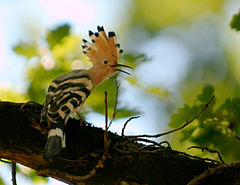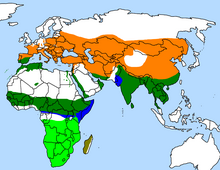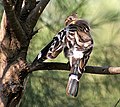Hoopoe
| Hoopoe | |
|---|---|

| |
| Scientific classification | |
| Kingdom: | |
| Phylum: | |
| Class: | |
| Order: | |
| Family: | Upupidae Leach, 1820
|
| Genus: | Upupa
|
| Species: | U. epops
|
| Binomial name | |
| Upupa epops Linnaeus, 1758
| |

| |
| Approximate range. nesting resident (all year) wintering | |
The Hoopoe (IPA: [ˈhuːpuː]) Upupa epops is a colourful bird that is found across Afro-Eurasia, notable for its distinctive 'crown' of feathers.
The Hoopoe is classfied in the Coraciiformes clade, a group that also includes kingfishers, bee-eaters, rollers and wood-hoopoes (forming a clade with this one according to Hackett et al (2008)[2]). In the Sibley-Ahlquist taxonomy, the Hoopoe is separated from the Coraciiformes as a separate order, the Upupiformes. It is the only extant member of its family, although what are now considered subspecies, such as the resident African form U. e. africana, were formerly sometimes given specific status. The Giant Hoopoe, U. antaios, lived on the island of St Helena but became extinct in the sixteenth century.
The Hoopoe is widespread in Europe, Asia and North Africa, as well as Sub-Saharan Africa and Madagascar. It migrates from all but the southernmost part of its range to the tropics in winter.
Description
The Hoopoe prefers open cultivated ground with short grass or bare patches, and spends much time on the ground hunting insects and worms[3]. It is 25–29 cm long, with a 44–48 cm wingspan and a long, thin beak weighing 46-70 grams. This black, white and pink bird is quite unmistakable, especially in its erratic flight, which is like that of a giant butterfly. The song is a trisyllabic "oop-oop-oop", which gives rise to its English and scientific names.
The nest is in a hole in a tree or wall. Like those of its relatives, the kingfishers, the nest tends to contain copious amounts of faeces and smell very foul as a protection against predators[3].
Hoopoes in popular culture
In the ancient Greek legend of Philomela, the evil king Tereus is transformed into a hoopoe at the end of the story.
In Valencian culture, the bird is known as the Palput, and is associated with the penis. [4]
European Hoopoes are featured heavily in the BBC childrens' television programme In the Night Garden, as part of a musical group of birds called the Tittifers.
A hoopoe character features prominently in Salman Rushdie's novel Haroun and the Sea of Stories.
Hoopoe birds take a recurring and important part in The Source (novel), a 1965 novel by James A. Michener.
National bird of Israel
The Long-Billed Hoopoe was chosen as the national bird of the State of Israel in May 2008 in conjunction with the country's 60th anniversary, following a national survey of 155,000 citizens, outpolling the Pycnonotus xanthopygos (White spectacled Bulbul).[5]
Gallery
-
In France (Toulouse)
-
In France (Toulouse)
-
Young in France (Toulouse)
-
Preening
References
- ^ Template:IUCN2006 Database entry includes justification for why this species is of least concern
- ^ A Phylogenomic Study of Birds Reveals Their Evolutionary History. Shannon J. Hackett, et al. Science 320, 1763 (2008).
- ^ a b Forshaw, Joseph (1991). Forshaw, Joseph (ed.). Encyclopaedia of Animals: Birds. London: Merehurst Press. pp. 147–148. ISBN 1-85391-186-0.
- ^ Template:Es icon "El pájaro más votado".
- ^ Reuters photo credit: Ofir Lotan (May 29 2008). "Day in pictures". San Francisco Chronicle.
{{cite web}}:|author=has generic name (help); Check date values in:|date=(help)
External links
- Ageing and sexing (PDF) by Javier Blasco-Zumeta
- Hoopoe videos on the Internet Bird Collection














